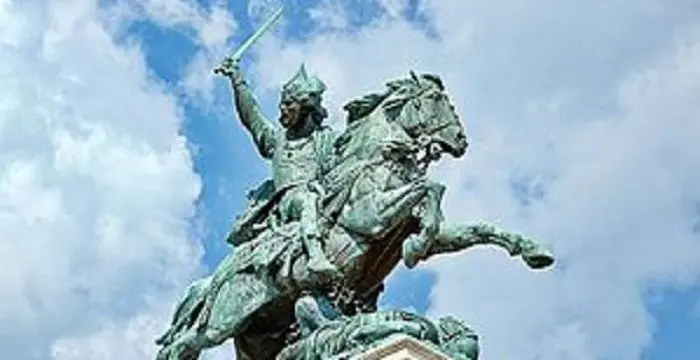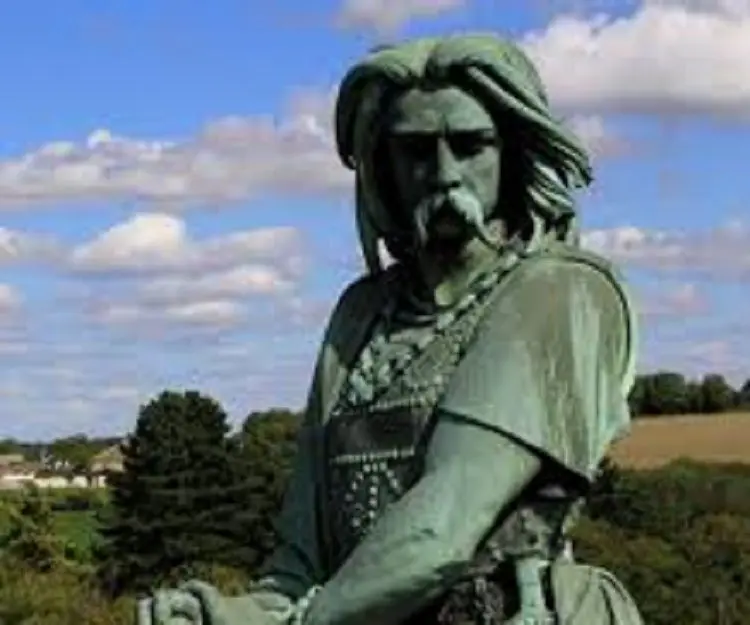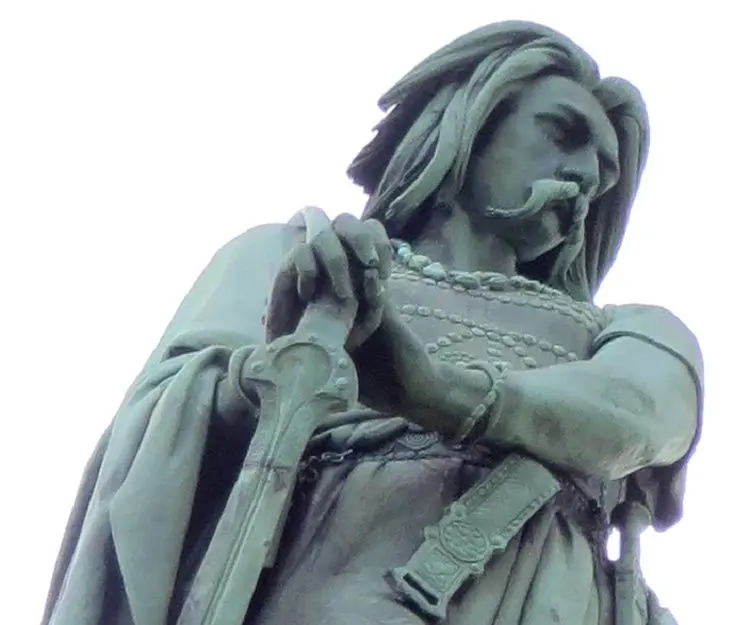
Vercingetorix - Kings, Birthday and Childhood
Vercingetorix's Personal Details
Vercingetorix was a chieftain of the Arverni tribe, who united all the Gallic tribes and launched a rebellion against Roman forces led by Julius Caesar
| Information | Detail |
|---|---|
| Birthday | 82 BC |
| Nationality | French |
| Famous | Historical Personalities, Emperors & Kings, Emperors, King of Arveni Tribe, Kings |
| Birth Place | Gergovie, France |
| Gender | Male |
| Father | Celtillos |
| Born in | Gergovie, France |
| Famous as | King of Arveni Tribe |
| Died at Age | 36 |
// Famous Kings
Sundiata Keita
Sundiata Keita was the founder of the Mali Empire in West Africa. This biography profiles his childhood, early life, struggles, founding of empire, rule, administration, achievements and also gives some fun facts.
Ashoka
Ashoka was the third emperor of the Mauryan Dynasty and ruled almost the entire Indian subcontinent. This biography profiles his childhood, life, reign, achievements and timeline
Murad IV
Murad IV was one of the mighty Sultans in the history of the Ottoman Empire. This biography profiles his childhood, family, accession, rule, administration and timeline.
Vercingetorix's photo
Who is Vercingetorix?
Vercingetorix was a chieftain of the Arverni tribe, who united all the Gallic tribes, became their unanimous king, and launched a rebellion against Roman forces during the last phase of Julius Caesar's Gallic Wars. Despite initial resistance from the nobles of the tribes, he was able to inspire a yearning for freedom into the downtrodden people and eventually gathered a large army combining all the Gallic tribes. He imposed rigorous vigilance within his army to make sure that his followers had unwavering determination to pursue his cause. He also introduced severe punishments to set frightening examples for his people. In the Battle of Gergovia, he severely crippled the Roman legion led by Julius Caesar. However, by the time he put up the resistance, Caesar had already taken control of much of the region by exploiting factionalism within Gallic tribes. Vercingetorix fought valiantly with meager support from allies in the Battle of Alesia, and finally surrendered to save his followers. He was executed five years later after being paraded through the streets of Rome.
// Famous Emperors
Sundiata Keita
Sundiata Keita was the founder of the Mali Empire in West Africa. This biography profiles his childhood, early life, struggles, founding of empire, rule, administration, achievements and also gives some fun facts.
Ashoka
Ashoka was the third emperor of the Mauryan Dynasty and ruled almost the entire Indian subcontinent. This biography profiles his childhood, life, reign, achievements and timeline
Murad IV
Murad IV was one of the mighty Sultans in the history of the Ottoman Empire. This biography profiles his childhood, family, accession, rule, administration and timeline.
Childhood & Early Life
Vercingetorix was born into the Arverni tribe, one of the most powerful Celtic tribes in ancient Gaul, in around 82 BC. The tribe is known for opposing the Roman invasion, led by Julius Caesar, on several occasions, and played a significant role in the Gallic Wars.
He was the son of Celtillus the Avernian, a leader who held supremacy over the entire Gallic tribes. However, his father was put to death by his own people reportedly for seeking sovereign power.
Leading the Gallic Revolt
In 58 BC, Julius Caesar was appointed governor of the Roman province of Gallia Narbonensis (modern Provence), and embarked on a mission to conquer the Gallic tribes. For the next few years, he controlled much of the region employing divide and rule strategy and manipulated the Gallic factions by providing selective political support, as well as luxury goods like wine.
Most of the resistance against the Roman conquest, like that of Ambiorix in 54 BC, were able to achieve local support only. However, Vercingetorix succeeded in uniting much of the Gallic tribes to fight against Caesar.
The uprising started on February 13, 53 BC, when the Carnutes of Cenabum slaughtered all the Roman merchants stationed in the town and killed one of Caesar's commissariat officers. Vercingetorix led his dependents to join the rebellion, but the elites, including his uncle Gobanitio, feared that such a revolt will only be hazardous for the tribe and expelled him and his followers from Gergovia.
Instead of being disheartened, he inspired the needy and the desperate tribesmen to take up arms for freedom and gathered a sizeable army. He soon attacked Gergovia, drove out the nobles, and was hailed as king by his followers.
He sent out ambassadors in every direction in hopes of making alliances and to inspire them about the great cause he was pursuing. Gradually, he was joined by the Senones, Parisii, Pictones, Cadurci, Turones, Aulerci, Lemovice, and the other tribes bordering the ocean, and was unanimously given supreme authority of their armies.
Immediately after gaining command of the states, he demanded a fixed number of soldiers from each tribe to be sent to him. He also regulated the quantity of arms each state needed to prepare at home, with particular attention to cavalry, and fixed deadlines as well for all that to be completed.
He soon gathered a huge army and marched to the north to take advantages of natural fortifications. He was one of the earliest commanders to employ the scorched earth strategy and burned down much of the towns in his path to deny provisions to the Roman army.
The town of Avaricum (now Bourges), the capital of the Bituriges, protested strongly to razing and burning, citing its naturally defendable terrain and strong man-made reinforcing defenses. As a result, he spared the town and camped outside its bounds, launching skirmish missions to harass the approaching Roman army, led by Caesar and his chief lieutenant Titus Labienus.
While it took the Romans 25 days of excruciating labor, they were eventually successful in capturing the capital, following which they slaughtered all but about 800 of the town's 40,000 population. Next, the Roman army marched to Gergovia, the capital city of the Arverni, but Vercingetorix and his men were able to crush Caesar's legions and allies.
He decided to follow the weakened Roman army, but both sides incurred heavy losses during the ensuing cavalry battle. He then retreated with his army to the stronghold of Alesia.
Caesar followed him back to the city and built a fortification around the city to lay siege on it during the 'Battle of Alesia' in September 52 BC. The few Gallic allies that came to his aid, were unable to reach Vercingetorix, the tactical leader, due to the doughnut-shaped fortification Caesar formed around the city.
The initial attack by the Gallic allies was unsuccessful, but was able to expose a weak point in the fortifications, which the combined forces on the inside and the outside were able to almost breach. However, Caesar personally led the last reserves of his army into battle and achieved a decisive victory for the Roman Empire.
Vercingetorix decided to surrender to make sure most of his men survived, and riding his beautifully adorned horse to the Roman camp, stripped himself off his armor and yielded at Caesar's feet. He was subsequently imprisoned in the Tullianum in Rome, and five years later, in 46 BC, was executed after being publicly displayed in Caesar's triumph.
Major Works
Vercingetorix is best known for successfully uniting most of the Gallic tribes against the invading Roman army. He also modernized the local armed forces by adopting more current styles of warfare.
Memorials
In 1865, Napoleon III constructed a seven-meter-tall Vercingétorix monument on the supposed site of Alesia to inspire French nationalism among his subjects. The statue was sculpted by Aimé Millet and the memorial structure was built by architect Eugène Viollet-le-Duc..
Among the numerous memorial statues of him erected in France during the 19th century, the statue by Frédéric Bartholdi, on Place de Jaude, in Clermont-Ferrand is particularly unique.
In Popular Culture
Vercingetorix has been immortalized on the pages of the very popular comic book series, 'Asterix', for which he was also one of the inspirations. Among his appearances, most notable are 'Asterix and the Chieftain's Shield' and 'Asterix the Gaul', which portray the story of his surrender more favorably.
He appears as one of the Great Generals in the 'Civilization' video games; is a playable commander in 'Total War: Arena' and is an enemy character in games like 'Praetorians' and 'Age of Empires'.
The 2001 French film, 'Vercingétorix' ('Druids' in English), depicts his life story from childhood to the 'Battle of Alesia'. The co-writer of the movie, Norman Spinrad, later published the historical novel 'The Druid King' in 2003.
Trivia
The work Vercingetorix has its roots in the Gaulish terms ver- (over or superior), cingeto- (warrior) and rix (king), and thus can be interpreted as either ‘great warrior king’ or ‘king of great warriors’. It is important to note that Plutarch, in his Life of Caesar, mentions the chieftain as Vergentorix.
Vercingetorix biography timelines
- // 82 BCVercingetorix was born into the Arverni tribe, one of the most powerful Celtic tribes in ancient Gaul, in around 82 BC. The tribe is known for opposing the Roman invasion, led by Julius Caesar, on several occasions, and played a significant role in the Gallic Wars.
- // 58 BCIn 58 BC, Julius Caesar was appointed governor of the Roman province of Gallia Narbonensis (modern Provence), and embarked on a mission to conquer the Gallic tribes. For the next few years, he controlled much of the region employing divide and rule strategy and manipulated the Gallic factions by providing selective political support, as well as luxury goods like wine.
- // 53 BCThe uprising started on February 13, 53 BC, when the Carnutes of Cenabum slaughtered all the Roman merchants stationed in the town and killed one of Caesar's commissariat officers. Vercingetorix led his dependents to join the rebellion, but the elites, including his uncle Gobanitio, feared that such a revolt will only be hazardous for the tribe and expelled him and his followers from Gergovia.
- // 46 BCVercingetorix decided to surrender to make sure most of his men survived, and riding his beautifully adorned horse to the Roman camp, stripped himself off his armor and yielded at Caesar's feet. He was subsequently imprisoned in the Tullianum in Rome, and five years later, in 46 BC, was executed after being publicly displayed in Caesar's triumph.
// Famous Historical Personalities
Sundiata Keita
Sundiata Keita was the founder of the Mali Empire in West Africa. This biography profiles his childhood, early life, struggles, founding of empire, rule, administration, achievements and also gives some fun facts.
Ashoka
Ashoka was the third emperor of the Mauryan Dynasty and ruled almost the entire Indian subcontinent. This biography profiles his childhood, life, reign, achievements and timeline
Jetsun Pema
Jetsun Pema is the Queen consort of Bhutan. Check out this biography to know about her childhood, family life, achievements and fun facts about her life.
Murad IV
Murad IV was one of the mighty Sultans in the history of the Ottoman Empire. This biography profiles his childhood, family, accession, rule, administration and timeline.
Xerxes I
Xerxes I (Xerxes the Great) was the fourth and the most famous king of the Archaemenid dynasty of Persia. This biography profiles his childhood, family, personal life, life history, achievements, campaigns, administration, death and other facts.
Sargon of Akkad
Sargon of Akkad, also called ‘Sargon the Great’, ‘Sarru-Kan’ and ‘Shar-Gani-Sharri’, was the founder and first king of the Akkadian Empire. This biography profiles his childhood, life, rule, administration, timeline, and gives some fun facts.
Vercingetorix's FAQ
When was Vercingetorix died?
Vercingetorix was died at 2020-04-14
Which age was Vercingetorix died?
Vercingetorix was died at age 36
Where is Vercingetorix's birth place?
Vercingetorix was born in Gergovie, France
What is Vercingetorix nationalities?
Vercingetorix's nationalities is French
Who is Vercingetorix's father?
Vercingetorix's father is Celtillos
How famous is Vercingetorix?
Vercingetorix is famouse as King of Arveni Tribe







